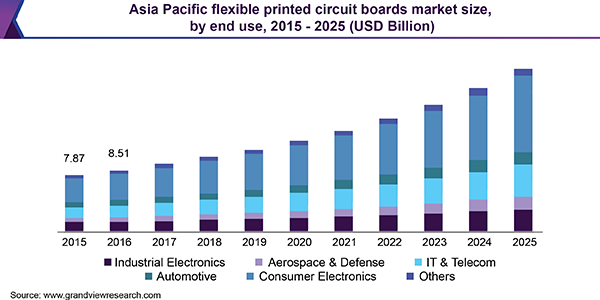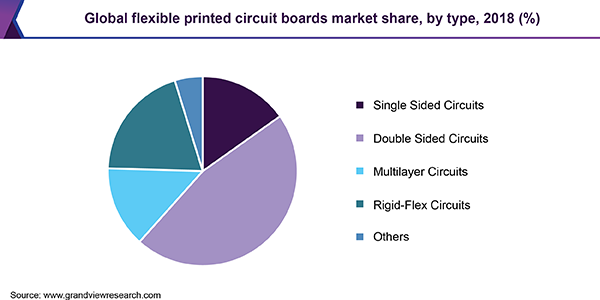- Home
- »
- Semiconductors
- »
-
Flexible Printed Circuit Boards Market, Flexible PCBs Industry, 2025GVR Report cover
![Flexible Printed Circuit Boards Market Size, Share & Trends Report]()
Flexible Printed Circuit Boards Market Size, Share & Trends Analysis Report By Type (Software, Service), By End Use (Consumer Electronics, IT & Telecom, Industrial Electronics), By Region, And Segment Forecasts, 2019 - 2025
- Report ID: GVR-4-68038-082-8
- Number of Report Pages: 80
- Format: PDF, Horizon Databook
- Historical Range: 2015 - 2017
- Forecast Period: 2019 - 2025
- Industry: Semiconductors & Electronics
Industry Insights
The global flexible printed circuit boards market was valued at USD 12.9 billion in 2018 and is projected to expand at a CAGR of 11.2% during the forecast period. The growth can be accredited to the rising demand for compact and flexible electronic devices across different industry verticals. Efficient interconnectivity offered by flexible printed circuit boards (FPCBs) in complex circuitry is further augmenting their adoption in electronics. Advances in technology leading to increased use of automotive electronics are expected to have a positive impact on the demand from the automotive segment.
Flexible PCBs simplifies the overall assembly design by limiting the need for wires and hence are lightweight and easy to install in any electronic device. Miniaturization of printed circuit boards and the development of green PCBs are some of the prominent trends shaping the flexible PCB industry. Moreover, features offered in terms of packaging flexibility and quality performance are further projected to fuel this market.

Manufacturers in developed economies, such as North America and Europe face stiff competition from the manufacturers operating in emerging economies in the Asia Pacific, due to their capability to develop low-cost variants. On the other hand, developments in polymer plastic solar cells and foldable smartphones are expected to open a plethora of opportunities for the manufacturers.
FPCBs are extensively used in an array of electronic devices that house complicated circuitry. In addition to superior interconnectivity, flexible PCBs have excellent electric induction and control performance which is gradually increasing their adoption in electronics. Because of a positive outlook, manufacturers are investing huge amounts for developing efficient flexible printed circuit boards. Manufacturers are also focusing on attaining enhancements in the fabrication technology and circuit materials to develop state-of-the-art flexible PCBs. For instance, in May 2019, DuPont, introduced a copper-clad laminate, Pyralux AG, to allow flexible circuit fabricators to seamlessly transit from prototypes to high volume manufacturing.
Type Insights
Based on type, the flexible printed circuit boards market is categorized into single-sided PCBs, double-sided PCBs, multilayer PCBs, and rigid-flex PCBs. The multilayer circuit segment is estimated to expand at a CAGR exceeding 12% over the forecast period. The rise in the adoption of multilayer circuits is majorly on account of increasing adoption in industry-specific applications and high-functioning electronics. Multilayer PCBs are extremely high-density assemblies making it more powerful and durable as compared to others and thus are expected to witness strong growth in the forthcoming years.
On the other hand, the double-sided PCB segment captured a prominent market share of more than 45% in 2018. Such boards allow designers to access circuit traces from both top and bottom of the circuit, thereby providing better flexibility in design. Also, benefits offered concerning circuit complexity, wiring errors, and weight among others has increased their adoption across industry verticals.
End-use Insights
The flexible printed circuit boards are employed in electronics used across varied industry verticals, such as industrial electronics, aerospace and defense, IT and telecom, automotive, and consumer electronics among others. The consumer electronics segment is expected to witness considerable expansion, at a CAGR of more than 12% during the forecast period, driven by the budding demand for flexible displays in smartphones, tablets, and PCs.

The IT and Telecom segment held a flexible PCBs market share of more than 15% in 2018. Advancements in digital technologies like Artificial Intelligence (AI) and 5G are expected to augment the need for high-speed electronics, thereby driving demand for highly efficient flexible printed circuit boards over rigid printed circuit boards. Flexible PCBs are lightweight and hence are preferred to be used in avionics, remote control equipment, and safety equipment.
Regional Insights
The Asia Pacific accounted for more than 77% of the overall revenue share in 2018, majorly attributed to the huge consumer electronics market. Countries such as China, Taiwan, Japan, and South Korea are semiconductor hubs and produce almost 80% of PCB production worldwide. Large scale investments in flexible printed circuit board manufacturing technology by semiconductor manufacturers, such as Xiamen Hongxin Electron-Tech Co., Ltd. is anticipated to boost the Asia Pacific FPCBs market growth in the forthcoming years.
North America is expected to expand at a CAGR of over 15% during the forecast period, accredited to the extensive demand from the military and aerospace sector. Additionally, the growing adoption of technology is contributing significantly to regional market growth. Furthermore, the steady demand for automotive electronics in Europe is fueling the adoption of flexible PCBs.
Flexible Printed Circuit Boards Market Share Insights
The ongoing trend of miniaturization and development of multi-feature electronic devices is pushing PCB manufacturers to produce highly dense and high-speed flexible PCBs. The market is highly consolidated with the top five manufacturers accounting for major share and generally determines the overall trend. Key players operating in the global market include AT&S; Benchmark Electronics; Cicor Management AG; Eltek Ltd; Flex Ltd; IEC Electronics, Jabil Inc.; SigmaTron International, Inc.; SMTC Corp; Sumitomo Electric Industries, Ltd.; and TTM Technologies. Companies are also emphasizing on lowering their operational costs by setting up manufacturing facilities requiring low capital investments.
The manufacturers are striving for higher efficiency in terms of material and design. They are focusing on strategic partnerships, acquisitions, mergers, product launches, and R&D investments to strengthen their market presence. For instance, in February 2016, Nippon Mektron Ltd. formed a strategic partnership with Orbotech, as a part of which Nippon deployed Orbotech’s digital direct imaging and automated optical inspection systems across its multiple manufacturing facilities. The partnership has helped Nippon to support its existing and future product performance requirements for manufacturing flexible printed circuit boards.
Report Scope
Attribute
Details
The base year for estimation
2018
Actual estimates/Historical data
2015 - 2017
Forecast period
2019 - 2025
Market representation
Revenue in USD Million and CAGR from 2019 to 2025
Regional scope
North America, Europe, Asia Pacific, Latin America, Middle East & Africa
Country scope
U.S., Canada, Germany, Italy, France, China, India, Japan, South Korea
Report coverage
Revenue forecast, company share, competitive landscape, growth factors, and trends
15% free customization scope (equivalent to 5 analyst working days)
If you need specific information that is not currently within the scope of the report, we will provide it to you as a part of the customization.
Segments Covered in the ReportThis report forecasts revenue growth at the global, regional, and country levels and provides an analysis of the latest industry trends from 2015 to 2025 in each of the sub-segments. For this study, Grand View Research has segmented the global flexible printed circuit boards market report based on type, end-use, and region:
-
Type Outlook (Revenue, USD Million, 2015 - 2025)
-
Single-Sided Circuits
-
Double-Sided Circuits
-
Multilayer Circuits
-
Rigid-Flex Circuits
-
Others
-
-
End-use Outlook (Revenue, USD Million, 2015 - 2025)
-
Industrial Electronics
-
Aerospace & Defense
-
IT & Telecom
-
Automotive
-
Consumer Electronics
-
Others
-
-
Regional Outlook (Revenue, USD Million, 2015 - 2025)
-
North America
-
Canada
-
The U.S.
-
-
Europe
-
Germany
-
Italy
-
France
-
-
Asia Pacific
-
China
-
India
-
Japan
-
South Korea
-
-
Latin America
-
Middle East & Africa
-
Share this report with your colleague or friend.
![gvr icn]()
NEED A CUSTOM REPORT?
We can customize every report - free of charge - including purchasing stand-alone sections or country-level reports, as well as offer affordable discounts for start-ups & universities. Contact us now
![Certified Icon]()
We are GDPR and CCPA compliant! Your transaction & personal information is safe and secure. For more details, please read our privacy policy.
We are committed towards customer satisfaction, and quality service.
"The quality of research they have done for us has been excellent."





